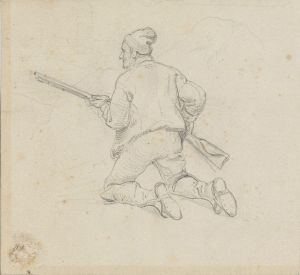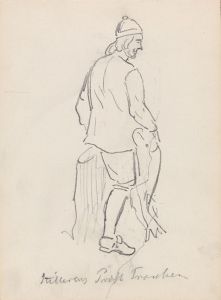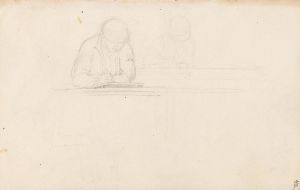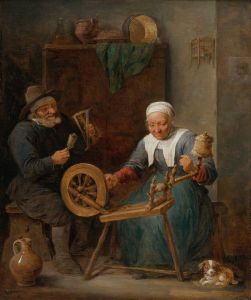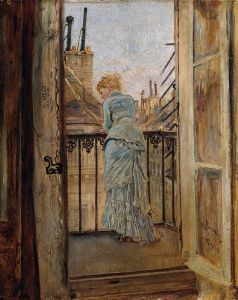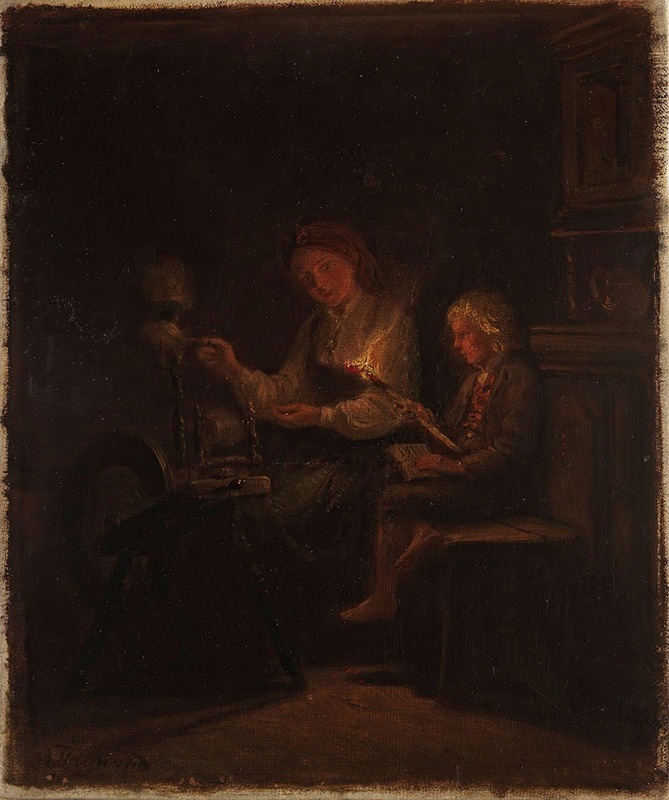
By the Spinning Wheel
A hand-painted replica of Adolph Tidemand’s masterpiece By the Spinning Wheel, meticulously crafted by professional artists to capture the true essence of the original. Each piece is created with museum-quality canvas and rare mineral pigments, carefully painted by experienced artists with delicate brushstrokes and rich, layered colors to perfectly recreate the texture of the original artwork. Unlike machine-printed reproductions, this hand-painted version brings the painting to life, infused with the artist’s emotions and skill in every stroke. Whether for personal collection or home decoration, it instantly elevates the artistic atmosphere of any space.
Adolph Tidemand was a prominent Norwegian painter in the 19th century, known for his detailed and evocative portrayals of Norwegian folk life and traditions. One of his notable works is "By the Spinning Wheel," which captures a quintessential scene of rural domestic life in Norway during this period.
"By the Spinning Wheel" is a genre painting, a style that Tidemand excelled in, which depicts everyday life and ordinary people. This particular painting illustrates a serene and intimate moment within a Norwegian household. The central focus of the painting is a woman seated by a spinning wheel, engaged in the traditional craft of spinning yarn. This activity was a common domestic task in rural Norway, reflecting the self-sufficient lifestyle of the time.
Tidemand's attention to detail is evident in the way he captures the textures of the woman's clothing, the wooden spinning wheel, and the modest interior of the home. The painting is characterized by its warm and earthy color palette, which adds to the sense of coziness and tranquility. The light in the painting is soft and natural, likely coming from a window, which highlights the woman's focused expression and the intricate details of the spinning wheel.
The setting of the painting provides insight into the cultural and historical context of 19th-century Norway. During this time, Norway was largely rural, and many people lived in small farming communities. The spinning wheel was an essential tool in these communities, used for producing yarn that would be woven into fabric for clothing and other textiles. By depicting this scene, Tidemand not only showcases a specific aspect of Norwegian life but also pays homage to the skills and labor of rural women.
Adolph Tidemand was part of the National Romantic movement, which sought to celebrate and preserve national identity through art. His works often emphasized themes of tradition, community, and the natural beauty of Norway. "By the Spinning Wheel" fits within this framework, as it highlights a traditional craft and the simplicity of rural life, evoking a sense of nostalgia and appreciation for Norway's cultural heritage.
Throughout his career, Tidemand traveled extensively throughout Norway, gathering inspiration from the landscapes and people he encountered. His paintings are valued not only for their artistic merit but also for their ethnographic significance, providing a visual record of Norwegian customs and daily life during the 19th century.
"By the Spinning Wheel" is a testament to Tidemand's skill in capturing the essence of Norwegian folk culture. It remains an important work within his oeuvre, illustrating his ability to combine technical proficiency with a deep understanding of his subjects. Through this painting, viewers are offered a glimpse into the past, experiencing a moment of quiet industry and domestic harmony that was central to the lives of many Norwegians in Tidemand's time.












